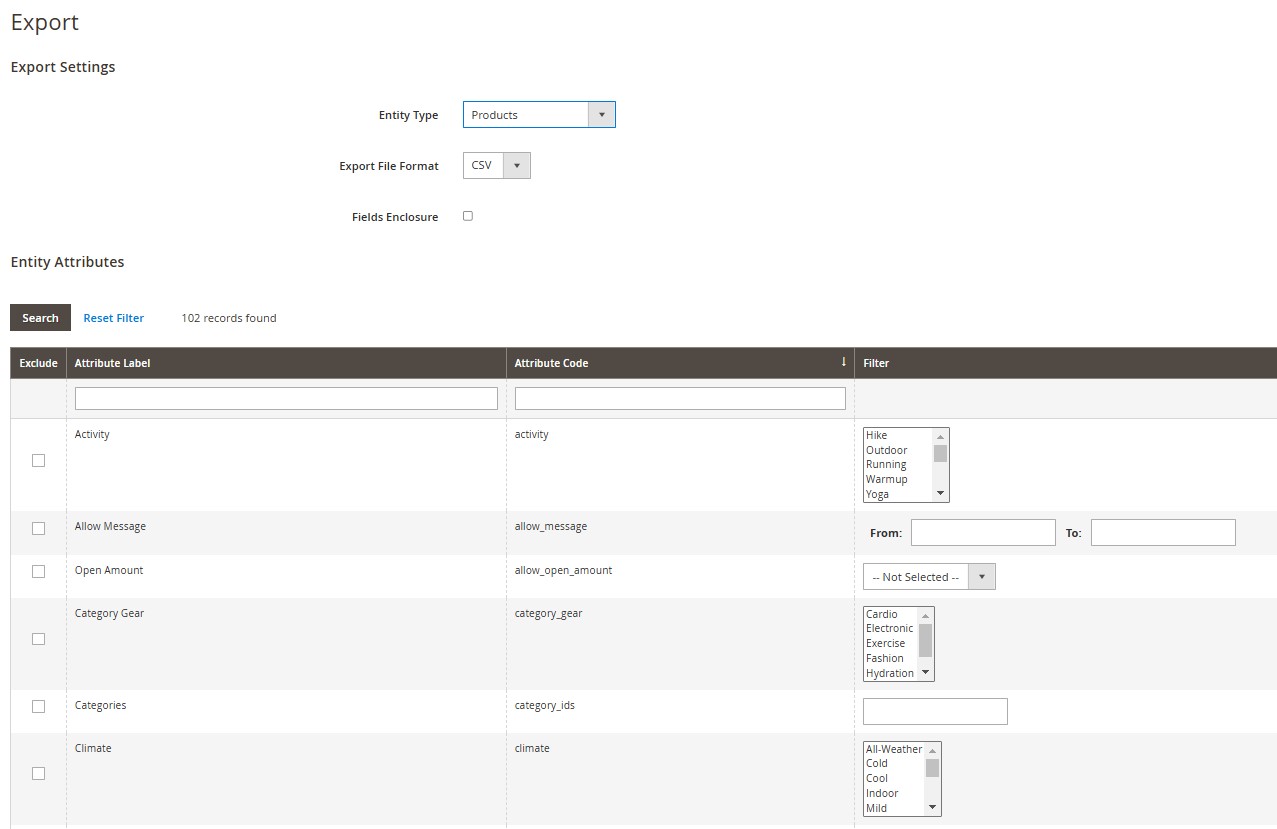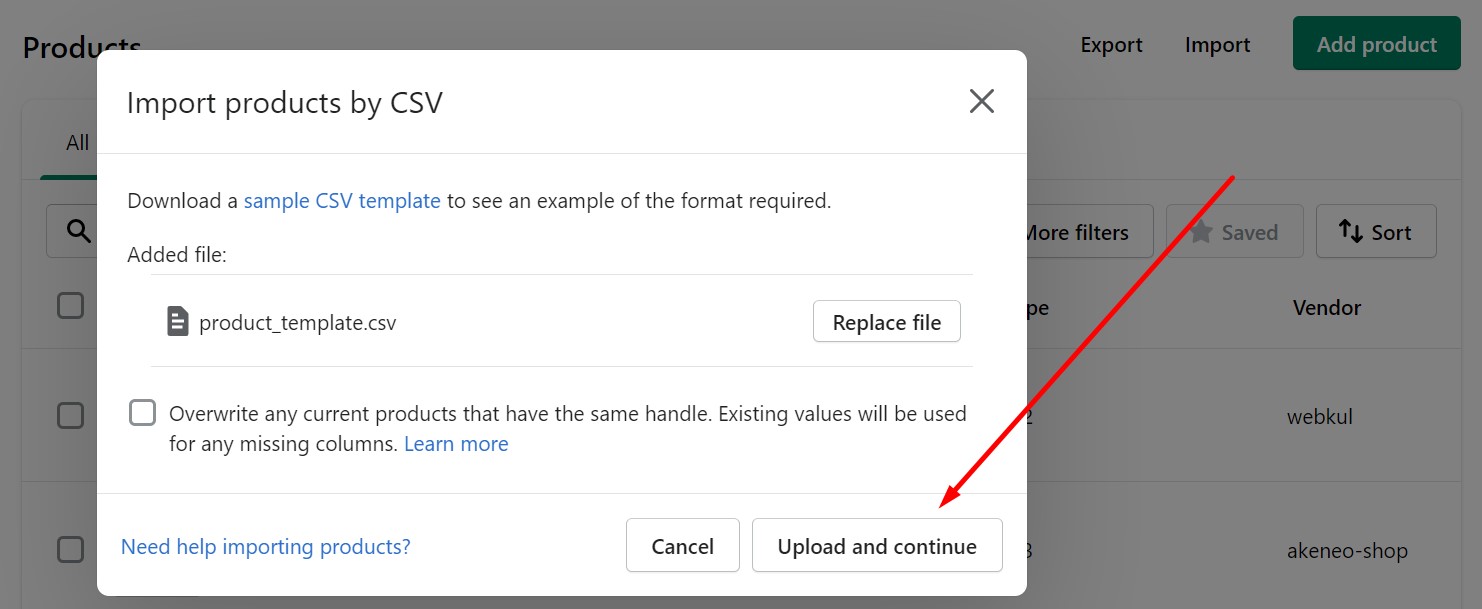Magento 2, Shopify
<!–
–>

The following article explores the Magento to Shopify product migration. While Magento 2 is a robust, feature-packed platform, it has certain limitations that may prompt you to consider switching to Shopify. Shopify, on the contrary, offers a simpler, user-friendly experience yet remains powerful enough to meet the needs of most e-commerce businesses.
In the sections below, we’ll walk you through each step of migrating products from Magento 2 to Shopify. You’ll find a comprehensive field reference table mapping Magento product attributes to their corresponding Shopify fields. We’ll then cover the Magento to Shopify product import process with a detailed, step-by-step guide for transferring simple products. For those with configurable products in Magento 2, we’ve also included a tailored migration tutorial.
Without further ado, let’s dive into the process. You can find other data transfers described in our Magento to Shopify migration guide.

Table of contents
- 1 Magento to Shopify Product Migration: CSV Field Reference
- 2 Magento to Shopify Product Import Step-by-step Guide
- 3 Magento to Shopify Product Import: Configurable Products
- 4 Challenges of Manual Product Migration from Magento to Shopify
- 5 Final Words
Magento to Shopify Product Migration: CSV Field Reference
Below, you will find a field reference table that maps Magento 2 product attributes to the ones used in Shopify. This information is essential for the Magento to Shopify product migration because the two systems use different column names to store product data.
| Shopify Product Attribute | Magento Product Attribute | Description | Required for Shopify Import |
| Handle | url_key | Defines the URL structure. Magento’s URL key corresponds to Shopify’s handle, which is part of the product page URL. | Yes |
| Title | name | Product name in Magento, corresponds to Title in Shopify, which appears on product pages and in search. | Yes |
| Body (HTML) | description | Full product description, which can include HTML formatting. | No |
| Vendor | manufacturer | Name of the product’s manufacturer, wholesaler, or other vendor. | No |
| Standardized Product Type | N/A | A predefined category that describes the product. Magento does not have a direct equivalent; categorization is typically managed through custom attributes or categories. | No |
| Custom Product Type | categories | A custom category for the product. In Magento, products are assigned to categories. | No |
| Tags | N/A | Tags used to label products for search and filtering. Magento uses attributes and categories for similar purposes but does not have a direct equivalent to Shopify’s tags. | No |
| Published | product_online | Indicates whether the product is published on the online store. In Magento, product_online (1 or 0) indicates if a product is enabled. | No |
| Option1 Name | N/A | Name of the first product option (e.g., “Size”). The default value is Title if no value is set.
If a product has only one option, then this value should be Title. |
No |
| Option1 Value | N/A | Value of the first product option (e.g., “Large”).
If a product has only one option, then this value should be Default Title. |
No |
| Option2 Name | N/A | Name of the second product option (e.g., “Color”). | No |
| Option2 Value | N/A | Value of the second product option (e.g., “Red”). | No |
| Option3 Name | N/A | Name of the third product option, if applicable. | No |
| Option3 Value | N/A | Value of the third product option, if applicable. | No |
| Variant SKU | sku | SKU of the product variant. In Magento, each product, including variants, has a unique sku. | No |
| Variant Grams | weight | Weight of the product variant in grams. Magento’s weight attribute is typically in the store’s base weight unit. | No |
| Variant Inventory Tracker | N/A | Inventory tracking method for the variant. Magento uses inventory management settings but does not have a direct equivalent to this field. | No |
| Variant Inventory Qty | qty | Quantity of the product variant in stock. In Magento, qty represents the stock quantity. | No |
| Variant Inventory Policy | N/A | Policy for selling the variant when out of stock (e.g., continue or deny). Magento handles backorders through stock status settings. | No |
| Variant Fulfillment Service | N/A | Fulfillment service for the variant. Magento does not have a direct equivalent; fulfillment is managed through shipping settings and extensions. | No |
| Variant Price | price | Selling price of the product variant. | No |
| Variant Compare at Price | special_price | Original price of the product variant before any discount. In Magento, special_price is used for discounted prices. | No |
| Variant Requires Shipping | is_virtual | Indicates if the product variant requires shipping. In Magento, is_virtual (1 or 0) specifies if a product is virtual (non-shippable). | No |
| Variant Taxable | tax_class_name | Indicates if the product variant is taxable. In Magento, tax_class_name assigns the tax class to the product. | No |
| Variant Barcode | N/A | Barcode (e.g., UPC, ISBN) for the product variant. Magento can store barcodes using custom attributes but does not have a default field for this. | No |
| Image Src | base_image | URL of the product image. In Magento, base_image refers to the main product image. | No |
| Image Position | N/A | Order of the image when multiple images are present. Magento handles image ordering through the admin interface but does not have a direct CSV field for this. | No |
| Image Alt Text | N/A | Alternative text for the product image. Magento allows setting alt text for images but does not have a direct CSV field for this. | No |
| Gift Card | N/A | Indicates if the product is a gift card. Magento handles gift cards through specific product types or extensions. | No |
| SEO Title | meta_title | SEO title for the product page. | No |
| SEO Description | meta_description | SEO description for the product page. | No |
Magento to Shopify Product Import Step-by-step Guide
Here’s a step-by-step guide for migrating simple products from Magento 2 to Shopify using Shopify’s CSV import structure. Simple products in Magento do not have variants and will map directly to Shopify’s product format.
Step 1: Export Simple Products from Magento
You can export products from Magento 2 as follows:
- In the Magento Admin, go to System > Data Transfer > Export.
- Choose Products as the entity type.
- Export the data as a CSV file.

Follow our guide to Magento 2 product import and export for a more detailed description.
Step 2: Download Shopify’s CSV Template
Now, you need to download Shopify’s CSV template with product data for further reference. Get the Shopify CSV Template as follows:
- In Shopify Admin, go to Products > Import and download the CSV template. This file will provide the necessary columns for importing products into Shopify.
- Shopify’s CSV template includes columns such as Handle, Title, Body (HTML), Vendor, Tags, Published, and Variant Price.

Step 3: Prepare and Map Magento Fields to Shopify
Since simple products don’t have options, you only need to map general product information to import Magento products to Shopify. Here’s a basic field mapping guide:
| Shopify Field | Magento Field | Description |
| Handle | url_key | Unique product identifier for URL generation. Use url_key or create a custom handle. |
| Title | name | Product name displayed on Shopify product pages. |
| Body (HTML) | description | Full product description, supports HTML formatting. |
| Vendor | manufacturer | Brand or vendor of the product. |
| Standardized Product Type | N/A | Optional product category from a predefined list. Not available in Magento. |
| Custom Product Type | categories | Custom category or type name. Use Magento’s category names or other labels if applicable. |
| Tags | N/A | Shopify product tags. These don’t have a direct Magento equivalent, so create as needed. |
| Published | product_online | Controls if the product is visible in the store. In Shopify, use TRUE/FALSE. |
| Variant SKU | sku | Unique identifier for each product, same in both platforms. |
| Variant Grams | weight | Product weight in grams, for shipping calculations. Convert Magento weight if needed. |
| Variant Inventory Qty | qty | Product stock quantity. Make sure this reflects the current stock. |
| Variant Price | price | The base selling price of the product. |
| Variant Compare at Price | special_price | Original price before any discount. Use special_price if applicable. |
| Variant Requires Shipping | is_virtual | Determines if the product requires shipping. Use TRUE for physical products and FALSE if virtual. |
| Variant Taxable | tax_class_name | Set to TRUE if the product is taxable; FALSE if not. |
| Image Src | base_image | URL to the main product image. |
| SEO Title | meta_title | Optional field for SEO purposes, used in the page’s title tag. |
| SEO Description | meta_description | Optional meta description for SEO purposes. |
Step 4: Populate Shopify CSV with Magento Data
Now, you need to create a CSV file suitable for the Magento to Shopify product migration. Follow these steps:
- Fill in Shopify-Specific Fields. Each row in Shopify represents a product, so there’s no need for multiple rows per product as with configurable products. Copy data from the Magento CSV to Shopify’s CSV following the mapped fields in Step 3.
- Set Up Handle Values. Shopify requires a unique Handle for each product to create URLs. If Magento’s url_key is available, use it here; otherwise, create custom, unique handles based on the product name.
- Format Prices and Weights. Ensure prices are consistent and formatted correctly. Convert Magento’s weight to grams for Shopify if necessary.
- Add Images. In the Image Src column, add the URL for the main product image. For local images, you’ll need to host them on an accessible server or platform so that Shopify can access them during import.
Step 5: Import and Verify in Shopify
So, you are almost there! Upload the CSV to Shopify. Go to Products > Import in Shopify Admin and upload your completed CSV file.

Congratulations! Your Magento to Shopify product migration is complete! Now, review products in Shopify to verify all information, including titles, descriptions, prices, inventory levels, and images. Follow our Shopify import guide for a more detailed description of a product import process.
Additional Tips
Follow these additional tips to migrate Magento products to Shopify:
- Use Tags and Categories: If you want to organize products, use the Tags and Custom Product Type columns in Shopify. You will need to fill them in manually.
- SEO Settings: Shopify provides SEO Title and SEO Description fields. Populate these with Magento’s meta_title and meta_description if available for better search engine optimization.
- Inventory: Double-check stock levels after import to ensure accuracy.
Following these steps, you’ll successfully migrate products from Magento to Shopify, preserving all essential product information. However, the procedure may vary a little bit if you deal with configurable products:
Magento to Shopify Product Import: Configurable Products
To migrate configurable products from Magento 2 to Shopify, you’ll need to map Magento’s attributes (used in configurable products) to Shopify’s product options (Option1 Name, Option1 Value, etc.) because Shopify handles product variations as options directly within a single product entry. Here’s a step-by-step guide to ensure a smooth transition:
Step 1: Export Your Magento Products
First, export Products from Magento:
- Go to System > Data Transfer > Export in the Magento Admin.
- Choose Products as the entity type and configure any specific export filters.
- Export the data to a CSV file, which will include configurable products and their associated simple products.

Next, identify Configurable Products and Variants:
- In Magento’s export, configurable products act as parent products, with associated simple products representing each variant (e.g., different sizes or colors).
- Take note of which attributes (such as size, color, etc.) are used in configurable products.
Step 2: Prepare Shopify CSV Structure
Now, you need to download Shopify’s CSV Template. You can do that under Products > Import in your admin. Note that Shopify handles product options using columns like Option1 Name, Option1 Value, Option2 Name, and so forth, allowing up to three options per product (e.g., Size, Color, Material).
Set Up option columns:
- Based on the Magento attributes you’ve identified (like size and color), plan how they will correspond to Shopify’s Option1 Name, Option1 Value, and so on.
- Example:
- Option1 Name = Size, Option1 Value = Large
- Option2 Name = Color, Option2 Value = Red
Step 3: Map Magento Configurable Products to Shopify Options
Now, follow these steps to map configurable products from your Magento 2 website to Shopify options. You need this to complete the Magento to Shopify product migration:
- Create Rows for Each Variant in Shopify’s CSV:
Each variant (Magento simple product) of a configurable product should be represented as a separate row in the Shopify CSV.
The first row for each product group represents the parent product (the configurable product in Magento). It includes product details but not Option1 Value, Option2 Value, etc.
Subsequent rows represent each variant, using Shopify’s Option1 Name and Option1 Value to define variations. - Map Magento Attributes to Shopify’s Option Columns. For each variant, enter:
- Handle: A unique identifier for the product, which should remain the same for all rows within one product group (configurable and its variants).
- Title: Name of the product, consistent for each variant.
- Option1 Name (e.g., Size) and Option1 Value (e.g., Large).
- Option2 Name and Option2 Value, if applicable (e.g., Color, Red).
Suppose you have a T-shirt in Magento with size and color attributes, and variants like:
- Small, Red
- Medium, Red
- Large, Blue
In Shopify’s CSV, this can be represented as follows:
- Handle = “t-shirt” for all rows
- Option1 Name = “Size”, Option2 Name = “Color”
- Row 1: Option1 Value = “Small”, Option2 Value = “Red”
- Row 2: Option1 Value = “Medium”, Option2 Value = “Red”
- Row 3: Option1 Value = “Large”, Option2 Value = “Blue”
Step 4: Complete Shopify-Specific Fields
There are only two fields required for Magento to Shopify product migration: Handle and Title. The rest of the fields you can use to fit your product information needs. Ensure these fields are filled in for each variant.
Also, note that Shopify allows an Image Src column for each row if you want different images for each variant. Otherwise, add an image for the main product row.
Step 5: Import CSV into Shopify
Now, you can import your CSV with Magento products to Shopify:

- In Shopify, go to Products > Import and upload your modified CSV.
- After importing, view each product in Shopify to ensure options and variants are set up as expected, mirroring your Magento configurations.
By following these steps, you can successfully migrate your Magento configurable products to Shopify while retaining the structure and options for your product variants.
Challenges of Manual Product Migration from Magento to Shopify
As you can see, migrating from Magento to Shopify can be a complex process, especially when handling it manually. While transferring data from Magento 2 to Shopify may seem straightforward, some specific challenges and downsides can make the process cumbersome and time-consuming. Here, we’ll break down the key difficulties associated with a manual Magento to Shopify product import and why it often requires specialized tools or expert support.
- Complex Product Structure in Magento. Magento 2 supports a wide range of product types, including simple, grouped, bundled, and configurable products with multiple options and variants. However, Shopify has a simpler structure. Migrating complex Magento products, especially configurable ones with multiple attribute sets, to Shopify’s option-based system can lead to data mismatches, requiring extensive manual adjustments.
- Attribute Mapping and Data Compatibility. Magento and Shopify use different attribute naming and data structures. For example, while Magento categorizes products with url_key, meta_description, and short_description fields, Shopify uses fields like Handle, SEO Description, and Body (HTML). Manually mapping each Magento attribute to the correct Shopify field can be labor-intensive, especially when dealing with large product catalogs. This mismatch often results in lost or incorrectly mapped data without a detailed migration plan.
- Handling Product Variants and Inventory. Configurable products in Magento rely on associated simple products to create variants (e.g., different sizes or colors), while Shopify uses an option-based system. Transferring these variations to Shopify can be challenging and may require extensive reformatting. Additionally, ensuring that inventory levels are accurately carried over and synchronized for each variant demands precision, especially for large inventories, increasing the risk of errors when done manually.
- Image Transfer and Re-organization. In Magento, images are managed through various attributes (base_image, thumbnail, small_image), while Shopify’s CSV requires URLs for product images. Manually exporting, uploading, and re-linking each image to products in Shopify not only takes time but also introduces potential errors, such as broken image links or misordered images.
- SEO Adjustments. A direct migration from Magento 2 to Shopify can also impact SEO if not managed carefully. Fields like meta_title, meta_description, and url_key in Magento don’t directly translate to Shopify’s SEO fields without customization. This may result in lost SEO data, affecting search engine rankings if fields are not optimized for Shopify’s structure during migration.
- Time and Effort Involved. Even with a small catalog, a manual Magento to Shopify product migration is labor-intensive. The process requires extensive checking and adjustment, especially for complex products or stores with custom fields and third-party extensions. Each step, from attribute mapping to image handling, involves meticulous work that can be costly and time-consuming without automation tools.
Considering these challenges, a manual Magento to Shopify product migration is often not ideal for businesses with large inventories or complex product types. However, you can contact Firebear to ask about the migration services we offer. Our portfolio includes powerful import and export tools for both Magento and Shopify. Utilizing automated migration tools and specialized migration services can streamline the process, minimize the risks of data loss, errors, and SEO disruptions, and save valuable time and resources.
Final Words
Migrating products from Magento to Shopify can open new opportunities for your e-commerce business but comes with its own set of challenges. From attribute mapping and inventory adjustments to SEO considerations, the process requires meticulous planning and expertise, especially if you’re managing complex or configurable products. However, with the right migration tools and professional services, you can significantly ease the transition, ensuring a seamless and accurate product import.
Whether you’re aiming to simplify your platform or enhance customer experience, the Magento to Shopify product migration process can help align your store with your evolving business needs. Start your journey today, leveraging automation and specialized support to save time, minimize errors, and preserve essential product information. Discover our data migration opportunities right now.

Please enable JavaScript to view the comments powered by Disqus.






